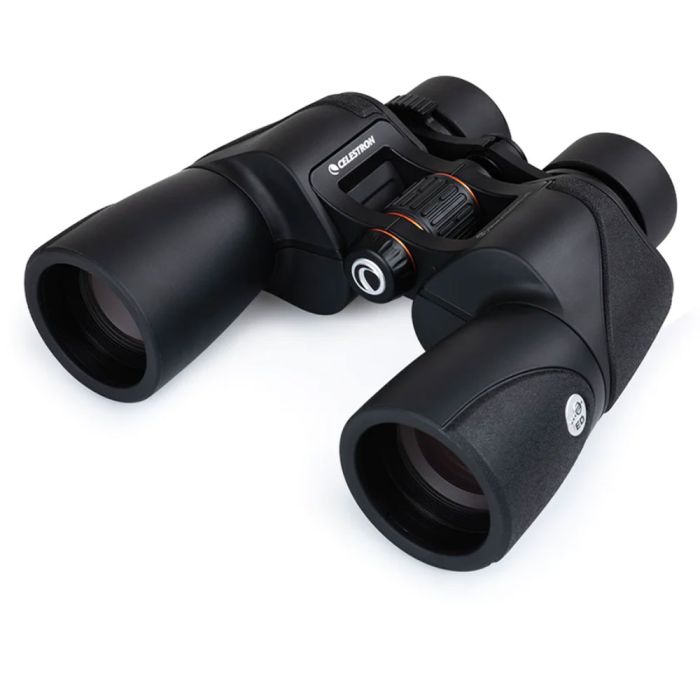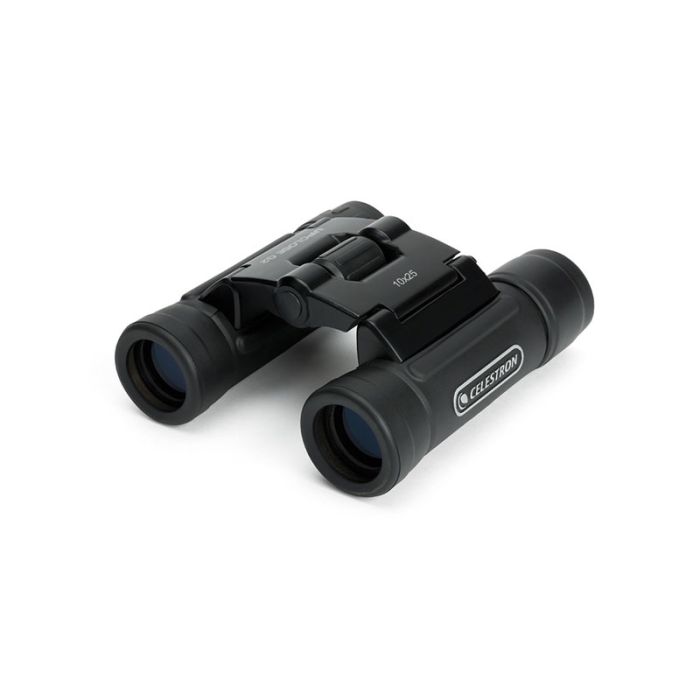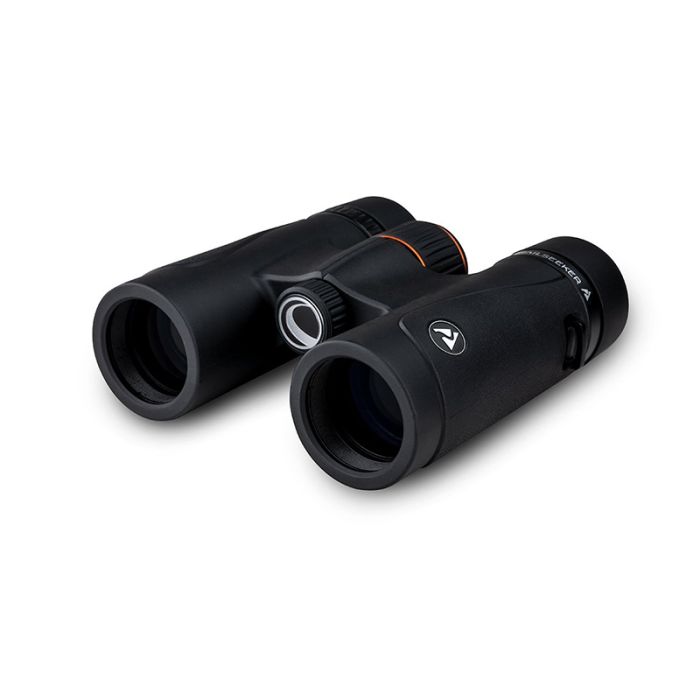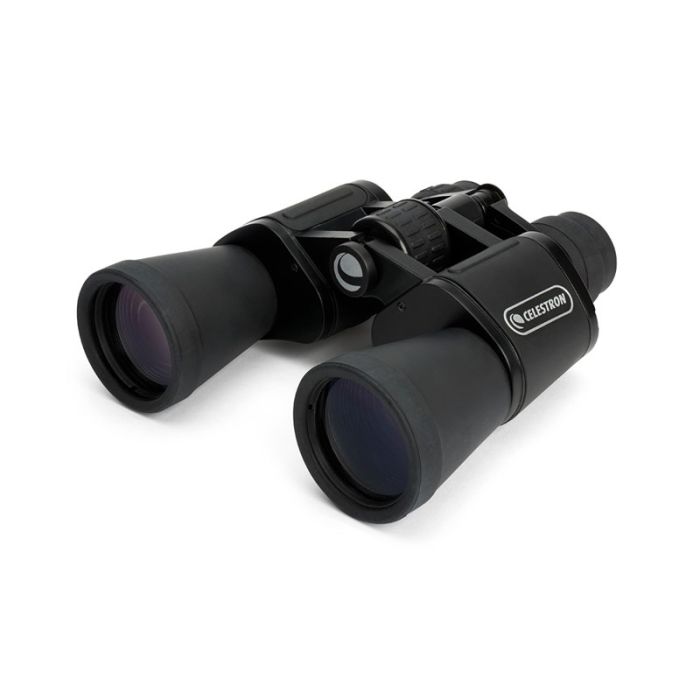
Optical ideas abound in binoculars and telescopes, which use mirrors or lenses to capture and amplify light. Some specialist telescopes offer stereo vision, combining aspects of optical instruments; others give wide-field views for object locating. For wide-field astrophotography, binoculars can be hooked to telescopes as finder scopes. Finding objects could thus be more guess and check than required. Pay attention and quickly learn how to position your finderscope correctly!
Highlighted Products
Featured Product 1
The Celestron TrailSeeker 10 X 32 Binoculars feature BaK-4 prisms with phase and dielectric coatings, a lightweight magnesium alloy body, and a 7.2' close focus for finer up-close detail. They have outstanding clarity, contrast, color-generating ability, and a large field for quick subject capture and movement. The durable metal multi-stop twist-up eyecups allow for eye relief adjustment.
Featured Product 2
Perfect for travel observations, the TrailSeeker 10x32 binoculars combine portability and clarity. Built on these benefits, the Celestron Nature DX 10x42 binoculars give customers higher performance in a more robust design. Larger objective lenses and ED glass enhance light transmission and color fidelity
Featured Product 3
With their water-resistant rubberized casing that shields optics from disturbances, the Celestron 10-30 x 50 UpClose G2 binoculars provide flexible zooming capabilities. The zoom lever can be easily located on a tripod with an optional hand-free viewing adaptor. They also include a soft carry case and a strap.
More About This Category
Binoculars and monoculars give a simple entry into night sky astronomy. Young people in astronomy and those who think using telescopes is relatively expensive or difficult will find these helpful. Only binoculars with a small objective lens diameter of more than 50mm and a lower power range from 7x to 10× will provide sufficient vision. This can display phases of Venus, lunar craters, Jupiter's moons, some star clusters, and nebulas' brilliance.
Binoculars: An Overview
Binocular vision exists and has depth sensation since binoculars are two telescopes set in parallel side by side. Their classification is 10x50; the second portion, expressed in millimeters, indicates the diameter of the objective lens, while the number preceding the "x" denotes the magnification power. Larger objective lenses gather more light when astronomical devices target at a distance. Therefore, in low illumination, binoculars are more helpful.
Porro Prism vs. Roof Prism Binoculars
Prisms allow binoculars to fix image orientation. Two primary forms of prisms are roof and porro prisms.
1. Porro Prism Binoculars: These binoculars are zigzag in arrangement from the prisms. Perfect for birdwatching and astronomy, this design gives better depth perception and a more comprehensive view range. Usually less expensive to build, they offer better optical performance at a lower cost than roof prisms. One disadvantage of Porro prism binoculars is their usual weight and bulk.
2. Roof Prism Binoculars: These binoculars' straight-barrelled form is more straightforward. The closely overlapping prisms enable a lighter and more compact structure. Often more costly, roof prisms depend on more extraordinary precision fabrication and better-quality coatings to match Porro prisms in optical performance. However, since mobility and strength are crucial for outdoor pursuits like hiking and hunting, their small size and durability appeal.
Half a pair of binoculars, monoculars are lightweight, tiny optical tubes ideal for outdoor activities, including travel or trekking. Their outstanding clarity and amplification are invaluable for terrestrial and limited astronomical observations. Binoculars and monoculars provide quick access to view the night sky for astronomical purposes, especially for beginners who might find telescopes too costly or complicated. Observations of craters, Venus phases, Jupiter moons, and brighter star clusters in stargazing call for big objective lenses with limited magnification.
Interesting Facts about Binoculars
A larger FOV is beneficial for tracking moving objects—including birds or wildlife—and scanning vast night sky areas.
- Exit Pupil: Exit pupil is the breadth of that specific patch of light coming out of the eyepiece. He or she calculates the objective lens diameter/magnification formula. Since the eye adjusts to night vision and the pupil contracts to about 5.5 mm, astronomical use and low light conditions call for an exit pupil of roughly 5-7 mm.
- Eye Relief: To reach clarity, one can withdraw from the eyepiece. Extra time for eye rest is vital, even more so for those who wear spectacles, since it lets them modify the viewing area to match the supplied eye strength without compromising focus.
- Image Stabilization: Some upscale binoculars use view stabilization technology to provide a constant view and aid in offset hand motions. Handy are high-magnitude binoculars and viewing from a moving platform, perhaps a boat or automobile.
The longevity and performance of binoculars and monoculars determine their maintenance. Regular cleaning with soft brushes or compressed air helps prevent dust formation. Avoid rough surfaces, store goods in a cool, dry area with lens caps and a protective case, look for alignment, and, if needed, see an expert for maximum performance.
Frequently Asked Questions
- What is the best magnification for binoculars used in astronomy?
In astronomy, binoculars magnifying 7x to 10x are perfect. A common problem with higher-magnitude binoculars is image wobbling, which this range offers enough resolution without. - How do I choose between Porro prism and roof prism binoculars?
If you value optical performance and a larger field of view, pick Porro prism binoculars; you don't mind a heavier design. If you require a more portable, sturdy, and compact solution, even if it means paying extra for equivalent optical quality, choose roof prism binoculars. - Are expensive binoculars always better?
While the most expensive binoculars are likely built better with multi-coatings and other features, mid-price ranges also provide outstanding quality. Select the binoculars most suited to your likes and requirements.
Here are some recommendations that may influence when choosing binoculars.

For amateur astronomers and those who view enormous distances, the Celestron Sky Master Pro ED binoculars are ideal. Using Celestron's unique XLT coating technique, they employ outstanding optics, coatings, internal parts, and housing materials, including big objective lenses, BaK-4 prisms, ED glass, and completely multi-coated optics. BaK-4 glass prisms for improved light transmission and fully multi-coated lens surfaces define the tripod-adaptable binocular characteristics. Extra-low dispersion (ED) glass in the binocular also almost eliminates chromatic aberration, producing crisper images. Perfect for scanning the heavens, viewing the Moon and planets, and investigating deep-sky objects, the 50mm objective lenses provide light-gathering capability for outstanding low-light performance. Particularly at dawn or dusk, the binocular is tripod-adaptable and fit for long-distance land-based observation.

Particularly over great distances, Celestron's Sky Masters Series of large-aperture binoculars are perfect for terrestrial or astronomical gazing. High-quality BAK-4 prisms and multi-coated lenses for maximum contrast abound in these models. The Celestron 10x25 UpClose G2 binoculars are a portable storage tool that is conveniently folded under the focusing bridge. Their rubberized body is water-resistant, shielding the optics from shocks and impacts. These binoculars, magnified 10X, offer up-close views free from image motion. Even with gloves, the concentrating wheel is ribbed and easily reachable. A soft carry case and a strap accompany the binoculars. They weigh 11 ounces (312g), have an IPD max of 72mm and a minimum of 58mm, a relative brightness of 6.25.

The Celestron SkyMaster 25x 100 Astronomy Binoculars are large-aperture binoculars for terrestrial use and astronomical gazing. They feature high-quality BAK-4 prisms and multi-coatings for maximum contrast. The binoculars also have a built-in tripod adaptable rod, a big aperture, and water resistance. Their angular field of view is 3°, their 25x magnification is 100mm aperture, and they weigh 157 ounces.


